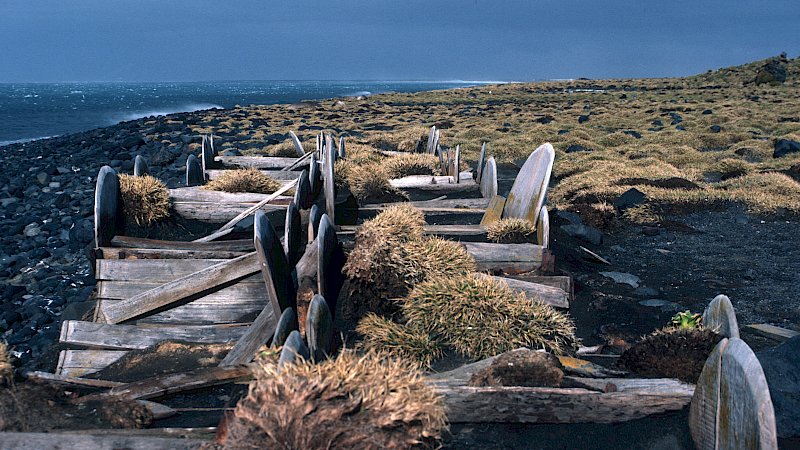The extreme isolation of Heard Island and McDonald Islands (HIMI), and the region's severe weather and sea conditions, mean human activities in the region have been limited.
The first recorded landing on Heard Island was in 1855. Since then, there have only been about 240 shore-based visits to the island, and only two landings on McDonald Island in 1971 and 1980.
Visits to Heard Island were initially associated with sealing and then research and management, private expeditions and for surveillance purposes.
An Australian commercial fishery, the Heard Island and McDonald Islands Fishery, operates in the region.
Terrestrial and marine research is the main human activity in the Marine Reserve.
Human activities on the islands are strictly managed in accordance with the relevant Australian IUCN Category Reserve Management Principles, including that all activities must be primarily for the purposes of scientific research or monitoring.
Research and management
Scientific studies have been carried out on Heard Island since the first research visit by scientists from the HMS Challenger in 1874.
The Australian National Antarctic Research Expedition (ANARE) – later known as the Australian Antarctic Division (AAD) - operated a station at Atlas Cove from 1947 to 1955.
Since then, the AAD has mounted over 30 Australian Antarctic program expeditions to the HIMI region to conduct science and environmental management activities, such as the removal of waste material from the Atlas Cove area.
Research has included a broad range of terrestrial and marine science disciplines, including geology, geomorphology, vulcanology, meteorology, terrestrial and marine ecology, glaciology, oceanography and cultural heritage study.
Recent scientific programs have focused on:
- Understanding the effects of climate change on the biodiversity and function of terrestrial and lake ecosystems;
- Studying the glacial systems of Heard Island as an indicator of climate change and variability;
- Monitoring long-term trends in seabird populations;
- Examining the interactions between key land-based marine predators and their interactions with prey, the ocean and benthic environment and commercial fisheries.
The AAD coordinates scientific research programs that address sustainable use of resources and ecosystem dynamics and contribute directly to management measures for the HIMI fishery. This research involves fish stock assessment surveys and studies of the foraging activity of land-based predators.
Private expeditions
The wildlife, vegetation, cultural heritage, spectacular landscape and remoteness of HIMI are major attractions for private recreational and tourist visits.
Due to the distance from major ports, there have been few privately-organised visits to the islands since sealing and whaling activities cased in the early 1900s.
A small number of private yachts and commercial tourist ships have visited Heard Island but few have landed.
Successful ascents of Big Ben have been made on three occasions: by members of the Southern Indian Ocean Expedition in 1965, by members of the Anaconda expedition in 1983 and by members of the Australian Army Alpine Association in 1999/2000.
Any individuals or organisations planning to conduct any activities in the Territory of Heard Island and McDonald Islands (HIMI) and/or the HIMI Marine Reserve, must have a permit.
All activities must be consistent with the applicable Australian IUCN Reserve Magagement Principles, as described in Schedule 8 of the Environment Protection and Biodiversity Conservation Regulations 2000, and in accordance with HIMI Territory and Marine Reserve boundaries and zoning.
Surveillance activities
Civilian and Australian Defence Force vessels conduct surveillance visits to HIMI, with the aim of enforcing fisheries legislation and detecting and deterring illegal foreign fishing activities within the HIMI Australian Fishing Zone (AFZ).
Patrols cover the waters of the Reserve and make landings at Heard Island to check for evidence of illegal activities and to undertake limited, opportunistic management tasks.
A treaty signed by Australia and France in 2003 also provides for cooperative surveillance activities in the adjacent exclusive economic zones (EEZs) surrounding HIMI and Îles Kerguelen. Under that treaty, French vessels may undertake surveillance patrols in the HIMI EEZ, including within the Reserve.
Fishing
Australian commercial fishing within the HIMI exclusive economic zone (EEZ) began in 1997, and targets mackerel icefish Champsocephalus gunnari and Patagonian toothfish Dissostichus eleginoides.
Commercial fishing is prohibited in the IUCN la and IUCN II zones of the HIMI Marine Reserve.
The HIMI fishery falls within the area of application of the Convention on the Conservation of Antarctic Marine Living Resources (CCAMLR) and, more specifically, within CCAMLR Statistical Division 58.5.2.
The fishery is managed under the provisions of the Fisheries Management Act 1991 and the Heard Island and McDonald Islands Fishery Management Plan 2002 by the Australian Fisheries Management Authority (AFMA), in a manner that complies with or exceeds the standards required by the CCAMLR Commission.
Conservation measures for fishing in the region include:
- Precautionary catch limits for both target and bycatch species, that take account of predator-prey relationships;
- Independent scientific observers on all voyages;
- Collection and analysis of a wide range of catch data and samples;
- Restrictions to minimise non-target species interactions,
- Ongoing research on the ecological sustainability of targeted and bycatch fish stocks.
More information about the HIMI fishery is available from the AFMA website.

